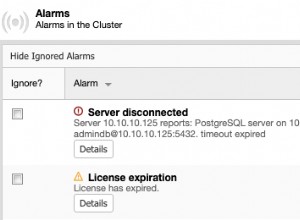Conectar o swift ao mysql e ao php é muito fácil. Primeiro você precisa de uma API REST. Você pode criar uma API de descanso usando qualquer estrutura disponível. Você também pode codificar seu Web Service usando apenas PHP. Então aqui vou mostrar o uso de qualquer framework php.
Então, primeiro crie um arquivo para armazenar suas constantes de banco de dados.
<?php
/**
* Created by PhpStorm.
* User: Belal
* Date: 12/08/16
* Time: 7:58 PM
*/
define('DB_USERNAME', 'root');
define('DB_PASSWORD', '');
define('DB_HOST', 'localhost');
define('DB_NAME', 'iphone');
Em seguida, crie outro arquivo php para criar a conexão com o banco de dados.
<?php
class DbConnect
{
private $conn;
function __construct()
{
}
/**
* Establishing database connection
* @return database connection handler
*/
function connect()
{
require_once 'Config.php';
// Connecting to mysql database
$this->conn = new mysqli(DB_HOST, DB_USERNAME, DB_PASSWORD, DB_NAME);
// Check for database connection error
if (mysqli_connect_errno()) {
echo "Failed to connect to MySQL: " . mysqli_connect_error();
}
// returing connection resource
return $this->conn;
}
}
Agora você precisa de mais um arquivo para lidar com suas operações de banco de dados.
<?php
class DbOperation
{
private $conn;
//Constructor
function __construct()
{
require_once dirname(__FILE__) . '/Config.php';
require_once dirname(__FILE__) . '/DbConnect.php';
// opening db connection
$db = new DbConnect();
$this->conn = $db->connect();
}
//Function to create a new user
public function createTeam($name, $memberCount)
{
$stmt = $this->conn->prepare("INSERT INTO team(name, member) values(?, ?)");
$stmt->bind_param("si", $name, $memberCount);
$result = $stmt->execute();
$stmt->close();
if ($result) {
return true;
} else {
return false;
}
}
}
Por fim, você precisa criar o arquivo php que manipulará sua solicitação http.
<?php
//creating response array
$response = array();
if($_SERVER['REQUEST_METHOD']=='POST'){
//getting values
$teamName = $_POST['name'];
$memberCount = $_POST['member'];
//including the db operation file
require_once '../includes/DbOperation.php';
$db = new DbOperation();
//inserting values
if($db->createTeam($teamName,$memberCount)){
$response['error']=false;
$response['message']='Team added successfully';
}else{
$response['error']=true;
$response['message']='Could not add team';
}
}else{
$response['error']=true;
$response['message']='You are not authorized';
}
echo json_encode($response);
Agora é só criar views no seu aplicativo iOS e ao clicar no botão enviar uma requisição para o seu arquivo php. O código é o seguinte.
//
// ViewController.swift
// SwiftPHPMySQL
//
// Created by Belal Khan on 12/08/16.
// Copyright © 2016 Belal Khan. All rights reserved.
//
import UIKit
class ViewController: UIViewController {
//URL to our web service
let URL_SAVE_TEAM = "http://192.168.1.103/MyWebService/api/createteam.php"
//TextFields declarations
@IBOutlet weak var textFieldName: UITextField!
@IBOutlet weak var textFieldMember: UITextField!
//Button action method
@IBAction func buttonSave(sender: UIButton) {
//created NSURL
let requestURL = NSURL(string: URL_SAVE_TEAM)
//creating NSMutableURLRequest
let request = NSMutableURLRequest(URL: requestURL!)
//setting the method to post
request.HTTPMethod = "POST"
//getting values from text fields
let teamName=textFieldName.text
let memberCount = textFieldMember.text
//creating the post parameter by concatenating the keys and values from text field
let postParameters = "name="+teamName!+"&member="+memberCount!;
//adding the parameters to request body
request.HTTPBody = postParameters.dataUsingEncoding(NSUTF8StringEncoding)
//creating a task to send the post request
let task = NSURLSession.sharedSession().dataTaskWithRequest(request){
data, response, error in
if error != nil{
print("error is \(error)")
return;
}
//parsing the response
do {
//converting resonse to NSDictionary
let myJSON = try NSJSONSerialization.JSONObjectWithData(data!, options: .MutableContainers) as? NSDictionary
//parsing the json
if let parseJSON = myJSON {
//creating a string
var msg : String!
//getting the json response
msg = parseJSON["message"] as! String?
//printing the response
print(msg)
}
} catch {
print(error)
}
}
//executing the task
task.resume()
}
override func viewDidLoad() {
super.viewDidLoad()
// Do any additional setup after loading the view, typically from a nib.
}
override func didReceiveMemoryWarning() {
super.didReceiveMemoryWarning()
// Dispose of any resources that can be recreated.
}
}
Mais uma coisa que você precisa fazer é adicionar as seguintes linhas dentro do seu arquivo Info.plist, isso porque, por padrão, você não pode enviar solicitações para urls não seguras, então, porque temos http, temos que fazer esta última coisa.
<!-- add from here -->
<key>NSAppTransportSecurity</key>
<dict>
<key>NSAllowsArbitraryLoads</key>
<true/>
<key>NSExceptionDomains</key>
<dict>
<key>yourdomain.com</key>
<dict>
<key>NSIncludesSubdomains</key>
<true/>
<key>NSThirdPartyExceptionRequiresForwardSecrecy</key>
<false/>
</dict>
</dict>
</dict>
<!-- end of the code -->
Fonte:Tutorial de banco de dados MySQL para iOS




